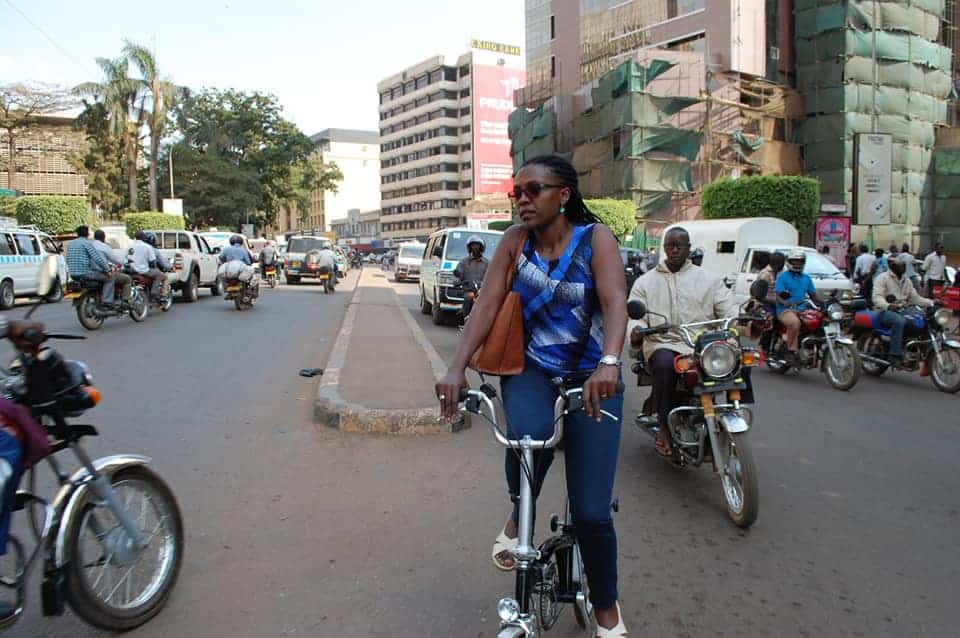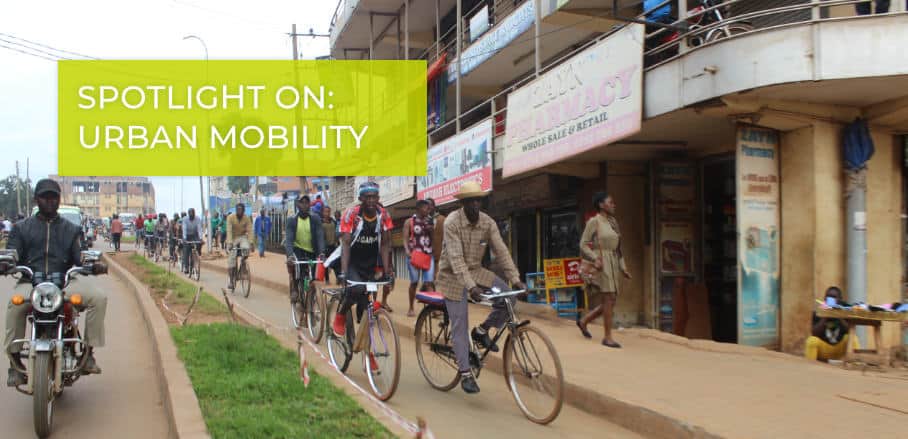Kampala’s Inspiring Journey Towards a Cycling-Friendly City
Uganda’s capital leads the way towards an increasingly popular mode of transportation: biking. In times of urbanisation, recent policies indicate a shift towards greater sustainability. Amanda Ngabirano, Vice President of the World Cycling Alliance, highlights the developments in the city of seven hills.
Uganda, like most developing countries, is undergoing rapid urbanisation, with the Greater Kampala Metropolitan Area alone contributing up to 10 per cent of the urbanisation growth rate . Although the establishment of several other cities were recently approved by parliament, Uganda still has only one city, her capital Kampala. This is increasingly becoming a matter of concern in terms of liveability and quality of public space, since density and most socio-economic activities are concentrated in this one area of space. Kampala attracts, after all, most investments and people from all over the country, leaving other towns lagging behind.
To address this continuous growth, the Kampala Capital City Authority (KCCA) has made tremendous progress in improving the road infrastructure network. However, there are still glaring gaps especially in relation to road safety and the quality of public space. A good number of roads still have potholes, open trenches and lack walkways, let alone bicycle infrastructure. Most of them are also inadequately lit or entirely dark. That’s why any mention of bicycle riding in Kampala will attract shock, fear and excitement at the same time – especially when the bicycle rider is a woman.
Kampala’s Mobility Experience
Female bike riders make the news in Uganda rather easily and tend to generate a lively and important debate on the situation of safety conditions, which is exactly why more women should ride in cities such as Kampala. In daily news, television, and radio, discussions point both to the poor behaviour of road users and the lack of appropriate infrastructure. In this regard it remains to be established whether or not poor road user behaviour is actually a result of everyone getting desperate to have a fair share of the road space. Kampala’s mobility experience is, after all, rather chaotic. The city’s road network is a perfect example of “share the road”, as all road users mostly use the same road space, most of the time and, regardless of road hierarchy. This leads to a lot of disorder and exacerbates the risk for conflict.
Despite all these issues, there are numerous visible bicycle riders, particularly in the morning and evening peak hours. After all, the city has a beautiful terrain and is commonly referred to as the city of seven hills. Some riders are commercial bicycle riders, who carry passengers at a fee. This goes to show that biking is about more than just mobility. It’s also about livelihoods for those who earn from this mode of transport. However, according to a 2010 survey conducted in the Kawempe division, 80 per cent of respondents wished to ride bicycles but hesitated due to concerns for their own safety. This reiterates that, if safety for all truly matters, city authorities must propose, plan and implement people-friendly designs – and national policies support this shift.
Local Strategies and Mobility Programs in Kampala
Uganda’s Non-Motorized Transport (NMT) policy, which was approved in 2012, clearly emphasises the need for the provision of safe facilities for active mobility users, particularly pedestrians, cyclists and people with reduced mobility. Indeed, Kampala authorities are currently implementing a pilot project in, what one could call, the heart of the city: Namirembe road and Luwum Street, the busiest and most crowded zones. It constitutes the city’s first real project with provisions for pedestrians, bicycle riders, motorists and green resting places. Up until then, mobility users had rather been forgotten in planning and design of road spaces.
Apart from Kampala’s bold infrastructural steps, the city has previously had a successful bicycle-sharing scheme. This was set-up as a pilot at Makerere University, with support from UN-Habitat. With only 15 bicycles, it was meant to last for six months but due to its popularity, it went on for 18 more months. The publicity it received through the mainstream media was excellent and eye-opening for the stakeholders involved. Kampala was also able to hold several car free days in its central business district, the first being held in 2011, with support from the Iganga Foundation. That car-free day sent out a strong wave of new discussions about the potential of cycling.
There have also been several other awareness programs, like open street days, mostly driven by applied research activities and advocacy groups like Uganda Sustainable Transport Network (UST-Network), in partnership with city authorities and traffic police. These activities enabled the public to appreciate their city without cars.

Cycling through Kampala © Amanda Ngabirano
Envisioning the Future of Mobility
Such projects may inspire the rest of the world in a sense that nothing will happen if nothing is planned and done. Generally, wherever plans pertaining to sustainability and mobility are in place, they are met with pessimism and referred to as too ambitious, while tasking the leadership to justify that kind of expenditure. In this regard, the Mayor of London, Sadiq Khan, has acknowledged in a previous speech how difficult a task the introduction of people-friendly mobility is:
“It has been an incredibly difficult few weeks for London, but we must carry on as a city and that means pushing forward our work to keep Londoners moving around our city […] our future health and prosperity is more and more dependent on us reducing our reliance on cars.”
Resistance towards people-centred plans can be easily managed, however, if there is a strong political will. It is important to remind all key stakeholders that efforts towards better cycling environments are not simply about advocacy for a specific road user group, but they are a bigger city planning issue. Better infrastructure will make it easier for commuters to choose cycling, thereby supporting compact and more sustainable cities. To that end, land use and mobility plans must be coordinated. Of course, it isn’t all about infrastructure planning and awareness; enforcement is a very important issue in Kampala too. The existing cycling lanes and sidewalks are occasionally used by motorists, making infrastructural provisions meaningless. This apparently is the same story in Nairobi, Kenya. This goes to show that without enforcement, cycling will remain unsafe even with safe infrastructure in place.
Nevertheless, within the East African region, Kampala has taken bold and major steps towards improving the cycling environment, from policy and planning to real implementation. Furthermore, with the current mobility restrictions due to the COVID-19 pandemic, cycling has been a saviour to many, as this mode of transportation enables the practice of social distancing. This might mark the beginning of a new desire for bicycles as a true mobility alternative and improved cycling infrastructure in Uganda. However, a lot of work is yet to be done in this regard.
- Kampala’s Inspiring Journey Towards a Cycling-Friendly City - 14. May 2020
